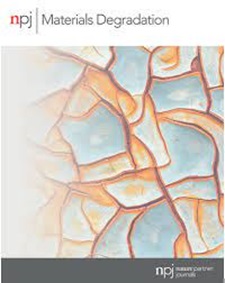利用时间分辨x射线显微断层扫描和相关电子显微镜研究AA7075腐蚀冻融损伤机制
IF 7.6
2区 材料科学
Q1 MATERIALS SCIENCE, MULTIDISCIPLINARY
引用次数: 0
摘要
铝制飞机结构暴露在腐蚀性的氯化物环境中会遭受严重的腐蚀,包括在上升和下降过程中残余水的循环冻结和融化,在腐蚀过程中引入了循环冻融成分。虽然飞机结构在恒温条件下的腐蚀机制已经得到了很好的研究,但在冻融条件下的微观结构和力学行为仍然不清楚。为了了解循环温度引起的转变,我们利用三维(3D) x射线计算机断层扫描(XCT)和扫描电子显微镜(SEM)研究了AA7075-T651在模拟海水环境中经历冻融循环的行为。浸泡在盐水中的棒在冰点以上和冰点以下进行热循环,并在三维上间歇性地表征结构变化。冻融条件下,由于冰的膨胀,腐蚀坑内部产生裂纹,导致裂缝沿夹杂物和晶界逐渐扩大和剥落,并伴有中等取向角偏差。比较了冻融和常规腐蚀环境下的损伤机制,以及与微观结构演变的关系。本文章由计算机程序翻译,如有差异,请以英文原文为准。

Mechanisms of corrosive freeze-thaw damage in AA7075 using time-resolved x-ray microtomography and correlative electron microscopy
Aluminum aircraft structures experience severe corrosion from exposure to aggressive chloride environments, including cyclic freezing and thawing of residual water during ascent and descent, introducing a cyclic freeze-thaw component to the corrosion process. While corrosion mechanisms in aircraft structures are well studied at constant temperatures, the microstructural and mechanistic behavior under freeze-and-thaw conditions remains unclear. To understand transformations induced by cyclic temperature, we used three-dimensional (3D) x-ray computed tomography (XCT) with scanning electron microscopy (SEM) to study the behavior of AA7075-T651 in a simulated seawater environment undergoing freezing and thawing cycles. Rods immersed in saltwater were thermally cycled above and below freezing, and structural changes were intermittently characterized in 3D. Under freeze-thaw conditions, cracks initiated within corrosion pits through ice expansion, causing progressive crevice growth and spalling along inclusions and grain boundaries with intermediate misorientation angles. Damage mechanisms in freeze-thaw and conventional corrosion environments are compared, with correlations to microstructural evolution.
求助全文
通过发布文献求助,成功后即可免费获取论文全文。
去求助
来源期刊

npj Materials Degradation
MATERIALS SCIENCE, MULTIDISCIPLINARY-
CiteScore
7.80
自引率
7.80%
发文量
86
审稿时长
6 weeks
期刊介绍:
npj Materials Degradation considers basic and applied research that explores all aspects of the degradation of metallic and non-metallic materials. The journal broadly defines ‘materials degradation’ as a reduction in the ability of a material to perform its task in-service as a result of environmental exposure.
The journal covers a broad range of topics including but not limited to:
-Degradation of metals, glasses, minerals, polymers, ceramics, cements and composites in natural and engineered environments, as a result of various stimuli
-Computational and experimental studies of degradation mechanisms and kinetics
-Characterization of degradation by traditional and emerging techniques
-New approaches and technologies for enhancing resistance to degradation
-Inspection and monitoring techniques for materials in-service, such as sensing technologies
 求助内容:
求助内容: 应助结果提醒方式:
应助结果提醒方式:


